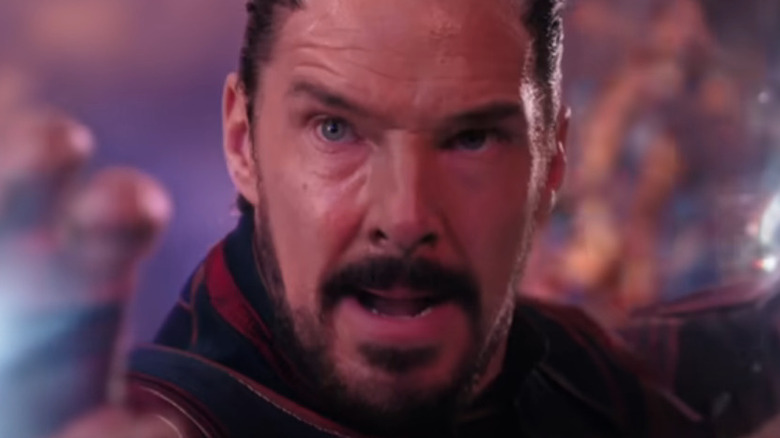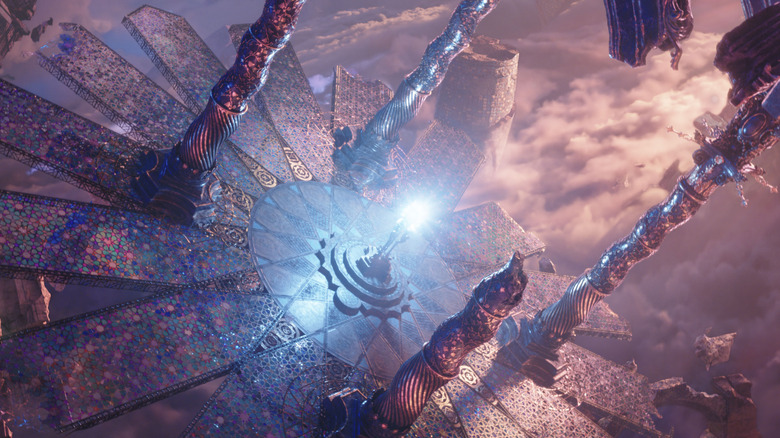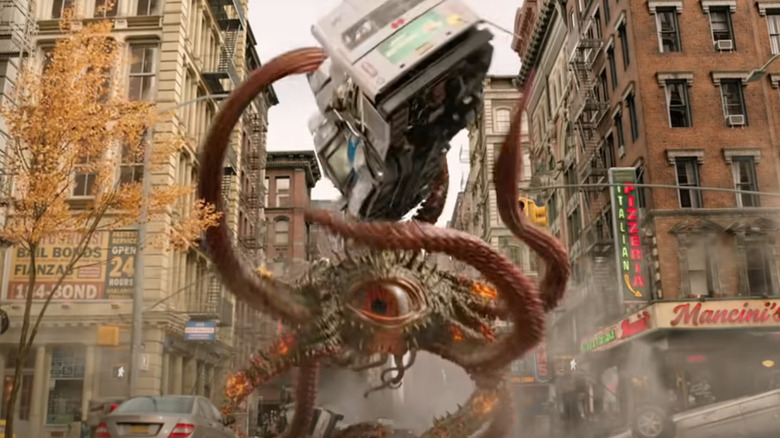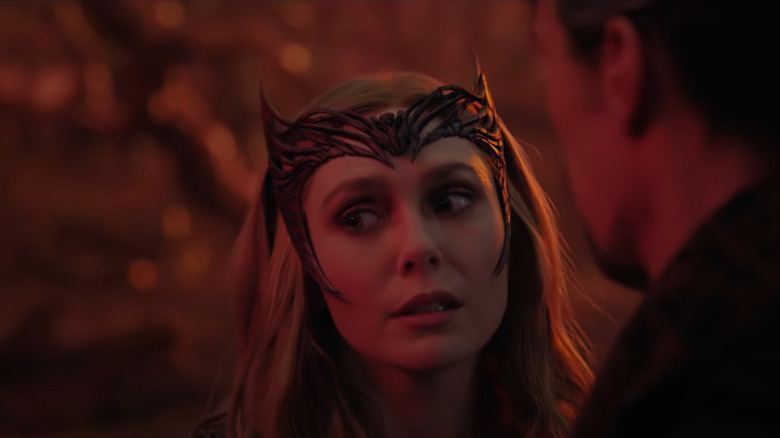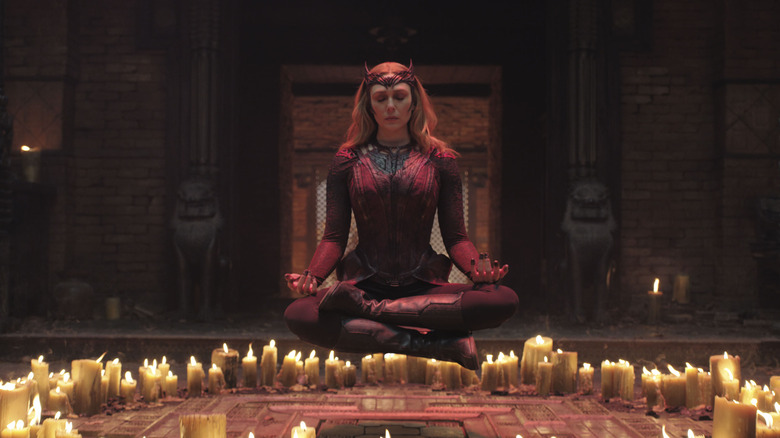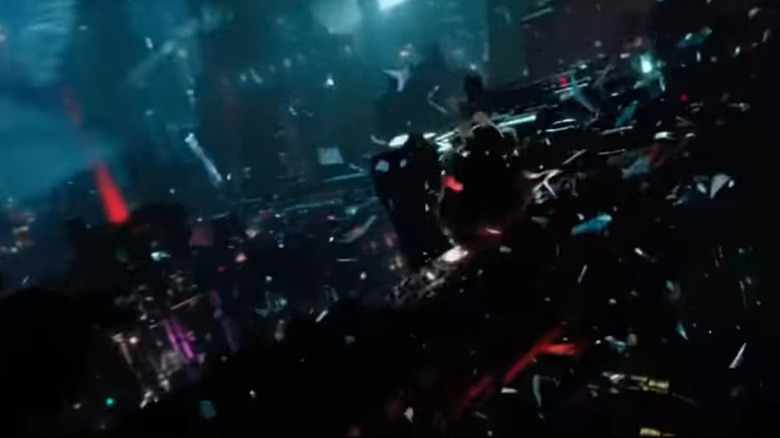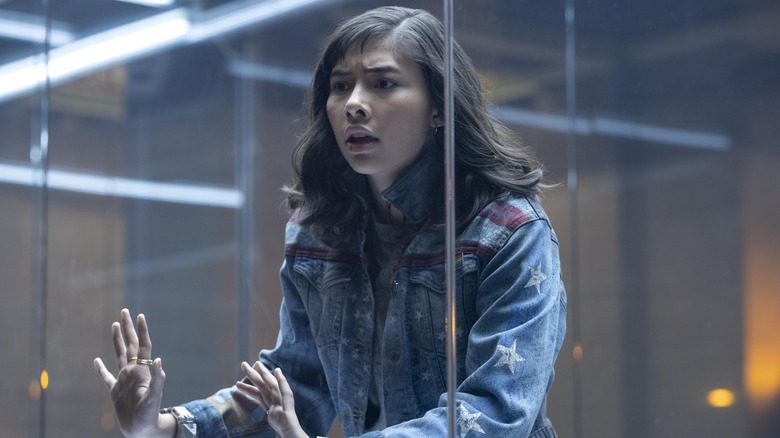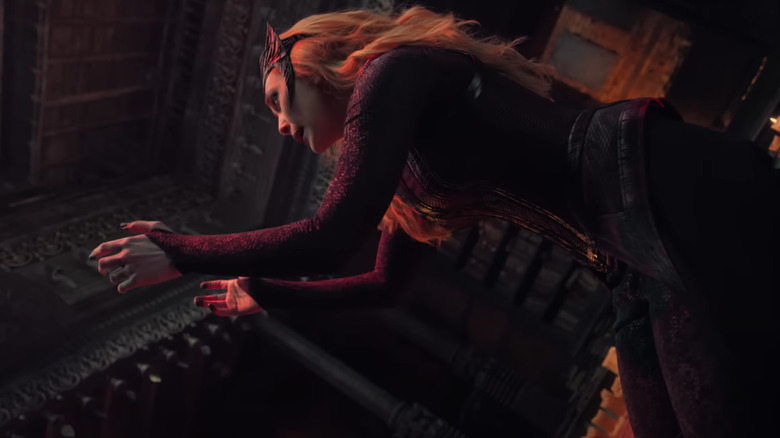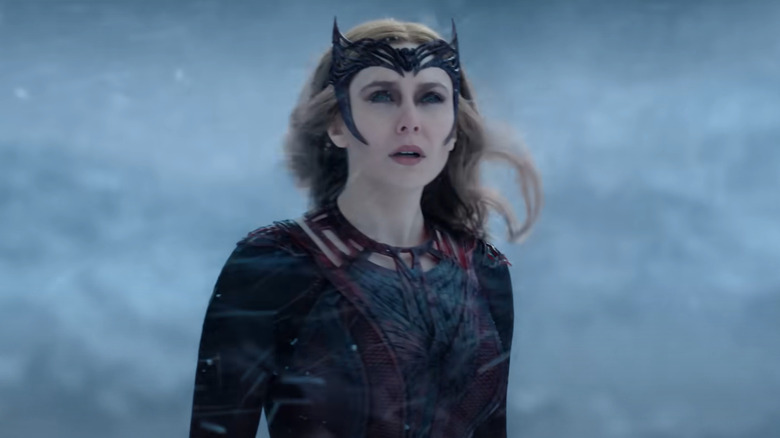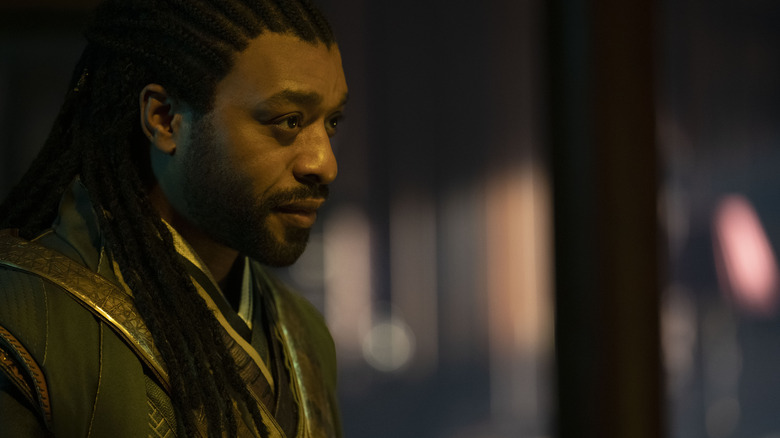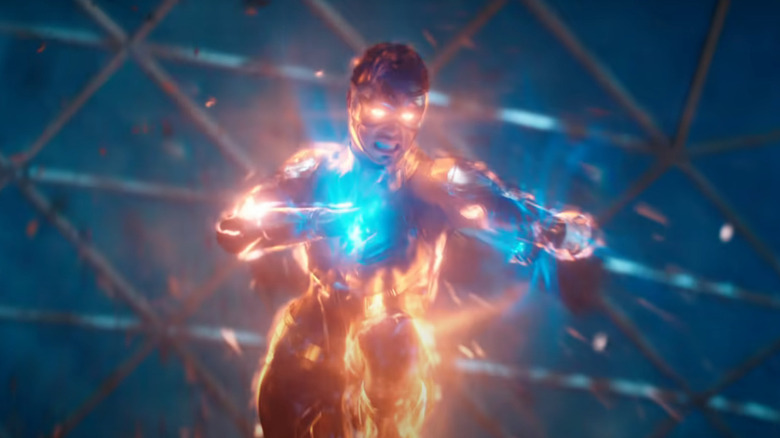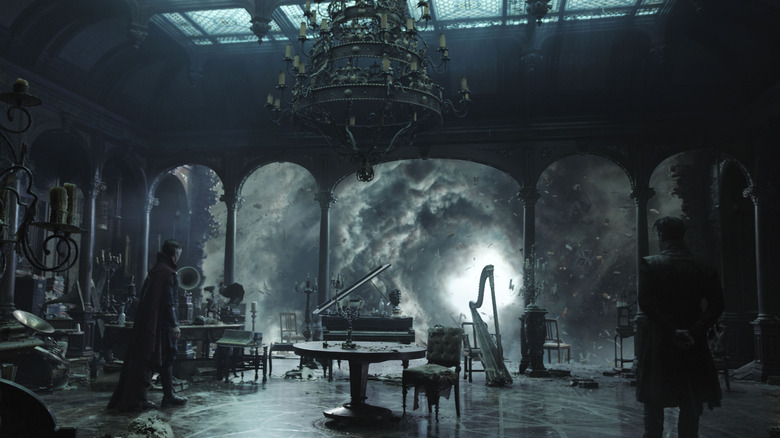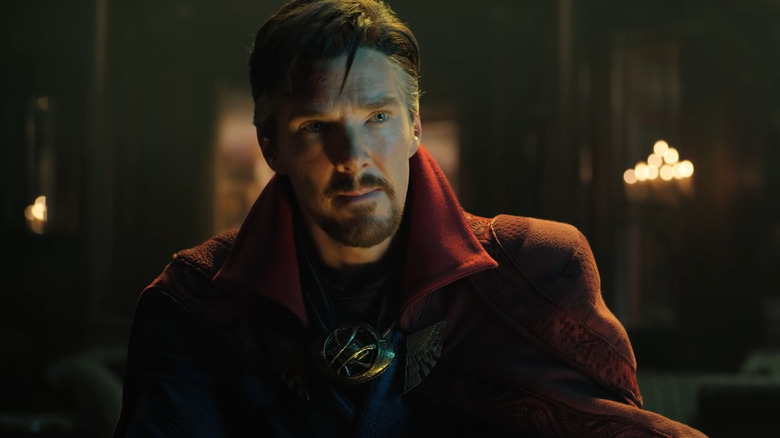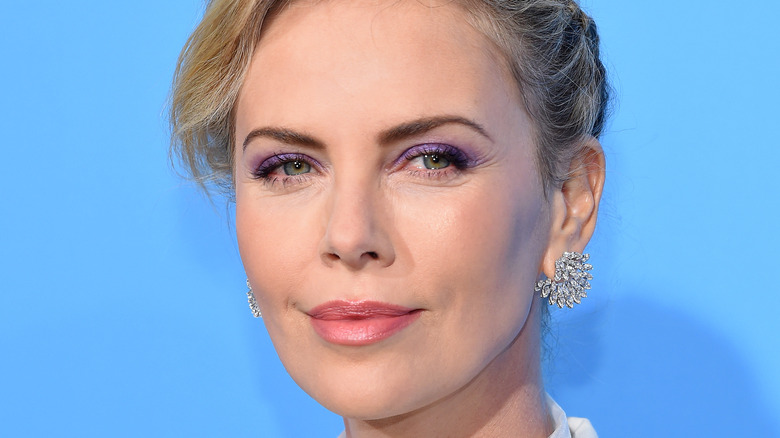Doctor Strange In The Multiverse Of Madness Scenes That Deserve A Second Watch
"Doctor Strange in the Multiverse of Madness" is a hectic hodgepodge of horror, science-fiction, and good old-fashioned superhero tropes. It blends the oddball style and visual flair that director Sam Raimi is known for with the psychedelic sci-fi storytelling of recent MCU fare like "Loki" and "Spider-Man: No Way Home." The result is a bit of a mixed bag — an assortment of impressive cinematic set pieces and rapid-fire revelations that are as important to the franchise as they are confusing in the moment.
Put simply, "Multiverse of Madness" is dense. Sometimes that plays to its advantage, sometimes not. Either way, there are a number of scenes throughout the film that benefit from a second watch. Whether they're visually complex moments that reward repeat viewings or baffling moments of mystical exposition that don't quite make sense the first time, the film is loaded with scenes that play quite different your second time through.
Here are some scenes from "Doctor Strange in the Multiverse of Madness" that deserve a second watch and what to keep an eye out for in them. Be warned, there will be major spoilers ahead.
The opening scene
"Multiverse of Madness" opens on a frenetic chase scene where America Chavez and a variant of Doctor Strange are shown running from a monster through a fractured dimension. It's quickly revealed that they're there in search of the mythical Book of Vishanti, and that the creature at their heels is after America's dimension-hopping powers. Your first time through, this info comes pretty fast and furious, and it isn't revealed until later that Scarlet Witch is actually the one behind the monster's attack.
Going through the opening sequence a second time, a number of things become clearer. You get a better look at the monster chasing them, which has a cool, ethereal look. The scene also drives home just how driven Scarlet Witch is to claim America's powers. The poor kid has basically been running for most of her life, and things only get more dire when Wanda enters the picture. Obviously, her attempts to capture America only grow more and more severe throughout the film, but even from the very start, she's clearly willing to do anything to make it happen.
The battle against Gargantos
After the beast Gargantos follows America to Earth-616, a huge fight breaks out in the middle of New York City. The battle quickly sets the tone for the kind of action viewers can expect throughout, and there are a lot of little touches that make it a fun rewatch. The tag-team fighting style of Doctor Strange and Wong is entertaining, and they each make creative use of their spell arsenals during the fight. There are also some distinct bits of Sam Raimi flair, such as in the brutal kill shot where Strange pulls the monster's giant eye straight out of its body.
Other highlights here to look for include the creature Doctor Strange summons for half a second to aid him (who then quickly returns through another portal to wherever he came from), and how the design of Gargantos actually mirrors a different Marvel Comics creature, the eldritch deity Shuma-Gorath. Due to a rights issue, the studio was unable to use that name in the film, so they combined the Shuma-Gorath character with that of the sea monster Gargantos (per ComicBook).
Wanda's orchard illusion
At first, Doctor Strange has no idea that Wanda's the one behind the attacks on America. In fact, he decides her knowledge of magic and witchcraft is exactly what they need to fight back. Strange journeys to Wanda's remote home to try to recruit her for the mission, finding her in an idyllic orchard with no signs of her old life. She suggests that America comes and stays with her, but she makes one big slip-up — dropping America's name before she actually hears it from Stephen. Doctor Strange quickly realizes the truth, and it's revealed that the thriving landscape is actually an illusion covering a desolate wasteland.
Going back to this scene a second time, you can see just how carefully Wanda plays her game of lies. She presents every possible objection and repeatedly claims that she's out of the superhero scene, lulling Strange into a perceived position of authority and power. Watching the scene after you've already finished the movie is also interesting because it complicates the mistake Wanda makes. She's so careful and so cunning for so much of the movie that feels bizarre for her to make such a simple slip. Later on, it's revealed that Wanda's core personality has been locked away within her own mind, dominated by a Scarlet Witch persona that's been corrupted by the Darkhold. Could Wanda's use of America's name be an intentional clue from the real Wanda — a desperate attempt to save the girl's life? Possibly.
Scarlet Witch vs. the Sorcerers
Once he discovers Wanda's true motives, Doctor Strange returns to Kamar-Taj and helps Wong fortify their defenses. They all know that the Scarlet Witch is coming, and they do everything they can to prepare. Unfortunately, none of it is enough, and the Masters of the mystic Arts are quickly decimated by Wanda's assault. The battle is swift and brutal, and it bears a second watch for a number of reasons.
First off, there are a number of important minor characters you take part in the battle. The green minotaur Rintrah, for instance, makes his MCU debut, but he barely spends any time on screen. In the comics, Rintrah is an important sorcerer who eventually serves as an apprentice to Doctor Strange himself. Another one of the sorcerers, who later sacrifices herself to destroy the Darkhold, is named Sara (played by Sheila Atim) — possibly a nod to the Marvel comics character Sara Wolfe, who works for Doctor Strange and has a brief romantic relationship with Wong.
The battle of Kamar-Taj is also worth rewatching for the magic alone. Wanda pulls off some truly wild moves, from powerful energy blasts (which leave her fingertips visibly scorched) to enchanted navigation of the fortress' reflective surfaces. The whole thing feels reminiscent of classic horror movies, which is surely intentional with Sam Raimi in the director's chair.
The multiverse drop
Doctor Strange, Wong, and the rest of the Kamar-Taj sorcerers give their all in the battle against Scarlet Witch, but it just isn't enough. Right when all seems lost, America opens another multiverse portal that pulls in both her and Doctor Strange, sending them plummeting through a number of strange worlds before landing on Earth-838. Their fall through the multiverse is undoubtedly one of the most striking scenes in the entire movie, and because each dimension they visit is only shown for a fraction of a second, the montage is built highly rewatchable.
Here are just some of the worlds glimpsed during Strange and America's multiverse drop: A retro-looking world painted in black and white (possibly a reference to Marvel's "Noir" comics); a universe in which everything is sloshing paint; a cosmic void inhabited by the Living Tribunal; a sci-fi metropolis in the style of Marvel's "2099" run; a prehistoric realm with dinosaurs; and a fiery hellscape. Thrown all together, these strange worlds make for a striking sequence, and you're bound to notice new details each time you see it.
Doctor Strange and America in Universe 838
After falling through a number of alternate dimensions, Doctor Strange and America Chavez are deposited in Universe 838 — a semi-futuristic reality where New York is overgrown with plants, Pizza is served in ball form, and a secret superhero group called the Illuminati runs the show. There are a lot of little details here that are easy to miss on your first time through, from the design of the street signs and storefronts to the numerous instances of mildly advanced technology.
Even before the Illuminati are introduced, Earth-838 has a lot of surprises — they're just ones that you might not notice right away. The early 838 scenes are also worth rewatching for America's tragic childhood flashback that's revealed by a piece of sci-fi memory tech. The machine shows how America grew up happily in an alternate reality, and how her world was shattered when her first accidental portal sucked in her mothers and left her all alone. In the comics, America's home realm is known as the Utopian Parallel, and while it isn't explicitly called by that name in the movie, a rewatch of the scene will reveal just how similar her universe looks to its comic book counterpart.
Wanda's first dreamwalk
In order to continue her pursuit of America into Universe 838, Wanda attempts a dark magical technique known as dreamwalking. The spell allows the caster to briefly take over the body of one of their variants in an alternate universe. On Earth-838, Wanda lives a seemingly peaceful life with her two sons. Earth-616's Scarlet Witch then possesses her unassuming counterpart in one of the most affecting scenes in the movie.
There are a lot of little details here that shine brighter on a rewatch — the classic Disney animation playing on the TV in the background, for instance, and the way Scarlet Witch leaks into the new universe through reflections and photographs. More than anything, though, this scene rewards repeated viewings because of Elizabeth Olsen's performance. When Earth-616's Wanda first takes control of her variant's body, there's a long, held shot close up on her face. She and the audience both hear Tommy and Billy calling for her attention, but she hesitates to turn and look. It's a powerful moment because it silently conveys a rush of complex emotions in Wanda's mind. She doesn't know how she'll react to seeing her boys in person again, so she resists the tempting urge to turn around for as long as she possibly can.
The moment is then interrupted when one of Wong's Sorcerers destroys the Darkhold, throwing Scarlet Witch back into her original body. The sideways shot of Wanda flashing back and forth between the two realities as she desperately grasps for her children is one of the most haunting in the entire film.
Wanda's arrival at Mount Wundagore
Scarlet Witch spends a good percentage of "Doctor Strange in the Multiverse of Madness" at Mount Wundagore, the source of the magic held within the Darkhold. From there, she's able to launch attacks across the multiverse. The scene where Wanda first arrives at Wundagore bears a second watch, as it's a hugely important moment for her character. The film goes through it pretty quickly, however, with only a handful of lines paid to the backstory of the mystical locale.
Wong briefly mentions that Mount Wundagore was once home to an ancient demon called Chthon, who carved his dark spells into the stone. In the comics, Chthon is one of the original Elder Gods of Earth, who later falls to the dark side and eventually leaves for another dimension altogether. His Chaos Magic is meddled with by Wanda Maximoff at an early age, causing a connection between the two. The MCU has yet to fully explain how its version of Wanda became exposed to Chaos Magic, but "WandaVision" makes it pretty clear that she had the ability before being subjected to Hydra's Infinity Stone experiments.
Watching the Mount Wundagore scenes again, there are some subtler things that quickly jump out. The walls have a lot more carvings than just the image of the Scarlet Witch, for instance, and the monsters who bow to Wanda have a classic Lovecraftian look to them, just as Chthon does in the comics.
The Illuminati council meeting
The "Multiverse of Madness" scene where Stephen is brought before the Illuminati is filled with Easter eggs, callbacks, and other fun little details. It's worth a rewatch just to get another look at all the characters' costumes. Charles Xavier's "X-Men: The Animated Series" look is fun to see in live action, as are Black Bolt's comics-accurate look the official design for the MCU's Fantastic Four outfits (still blue spandex, but a bit sleeker and more modern than past film versions).
Watching the Illuminati meeting a second time also shows what fans might be able to expect from the franchise's upcoming "Fantastic Four" and "X-Men" projects. Patrick Stewart's Professor X is a bit more cartoonish than his counterpart in the Fox movies, and while that doesn't guarantee anything about what's to come for the mutant team in the MCU, it's interesting to see such a distinct style at play. The same goes for John Krasinski's Reed Richards, whose measured and even demeanor — combined with his age — foreshadow a very different "Fantastic Four" movie than the ones previously produced. If you're a diehard Marvel fan, this is a scene you'll probably be watching over and over again.
The Illuminati fight
While it's fun just to see the Illuminati all assembled, it's even more exciting to see them in action, and "Multiverse of Madness" delivers that with a brutal battle against the Scarlet Witch. Reed tries to talk her down from her violent path, but she refuses to yield. The ensuing fight quickly turns into a bloodbath, with every Illuminati member who attacks her meeting their end.
Like the best action scenes in the "Avengers" movies, the Illuminati battle benefits immensely from the sheer number of characters in the mix. It's interesting to see the distinct ways each hero tries to take Wanda down. Captain Carter uses her speed and wits to deliver some tricky shield attacks, while Captain Marvel goes for a headfirst bombardment. These little details help to establish a lot of extra depth for the Illuminati characters, even in the brief time they spend on the screen. The fight choreography is densely packed with distinct moves and cleverly employed superpowers, and you're bound to pick up on some previously missed moments your second time through. All in all, this is one of the most action-packed moments of the entire film, as well as one of the most gruesome.
Doctor Strange vs. Doctor Strange
The fight between Scarlet Witch and the Illuminati is exciting to be sure, but it's far from the most stylish action scene in "Doctor Strange in the Multiverse of Madness." That honor belongs to a later duel, fought between the Stephen Strange of Earth-616 and his sinister doppelganger. The two meet in a desolate tower, standing alone in a universe demolished by an incursion. The evil Strange is revealed to have been corrupted by the Darkhold, and a visually stunning contest of magic follows suit.
The battle of the Stranges feels unlike any other MCU fight scene, mostly because of its musical nature. Both sorcerers use the musical notes around the room (which includes a piano and an impressive collection of sheet music) as runes, delivering gorgeous and haunting memories alongside their blows. It's one of the most creative sequences in the whole movie, and it bears a second viewing on the merits of its style alone.
Doctor Strange using the Darkhold
"Doctor Strange in the Multiverse of Madness" becomes properly unhinged after Stephen defeats his evil counterpart. He takes his variant's copy of the Darkhold and conducts his first dreamwalk — into the corpse of the variant from the first scene. His necromancy is then detected by an army of ghouls who Strange calls "the souls of the damned." After a brief struggle, Strange brings the ghost under his control and uses them as wings to fly up Mount Wundagore.
Sam Raimi's influence is on full display during the Darkhold scene, and not just because summoning the dead with dark rituals is basically the whole plot of the "Evil Dead" franchise. The director's style is also intensely evident in the body horror, the grotesquerie, and the campiness of it all. Christine lets out a deliciously corny "Go back to Hell!" while burning the spirits with mystical fire — the kind of quip you'd expect to hear in one of the Tobey Maguire "Spider-Man" movies.
The absurd tone of the necromancy sequence makes it a great rewatch, but a second viewing also helps it just make more sense. The strangeness of it all (pardon the pun) makes the whole zombies-and-ghosts thing a bit hard to follow the first time, through.
The Doctor Strange in the Multiverse of Madness post-credits scene
MCU post-credits scenes tend to set up big things, and the one in "Doctor Strange in the Multiverse of Madness" is no exception. While walking down the street, Doctor Strange is accosted by a woman named Clea (Charlize Theron), clad in purple warrior garb and wielding an impressive blade. She recruits Stephen for a mission to "fix" a multiverse incursion, and slices open a portal to an alternate dimension for them to travel through.
In the comics, Clea is a hugely important character to Doctor Strange's core story. She fights alongside him in several battles against Dormammu and even marries him later on, though her extensive time spent in her home realm of the Dark Dimension puts a strain on their relationship. If you watch the scene a second time, it's easy to notice that the universe she opens a portal to looks a lot like the MCU's Dark Dimension. That would mean both that Clea's origin story is staying consistent with the comics and that Dormammu may be back as the big bad of "Doctor Strange 3." A second viewing also helps you get a better look at Clea's MCU design. If she's as tough as her battle armor makes her look, then the next "Doctor Strange" movie should be pretty action-packed.
